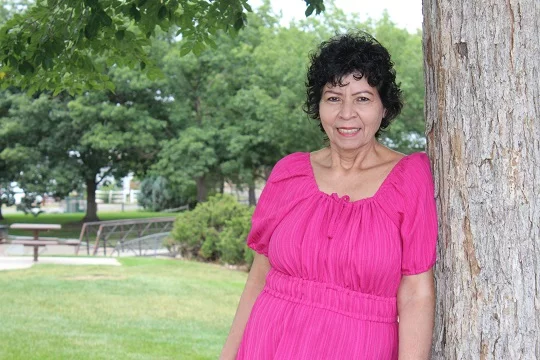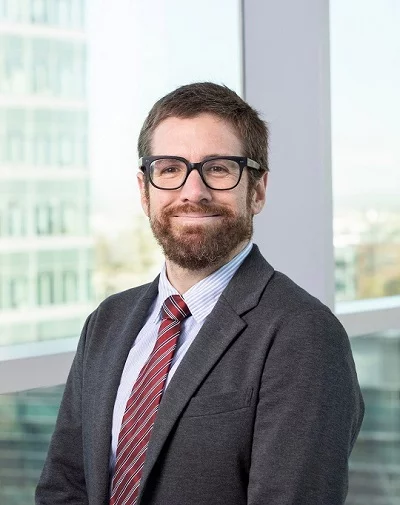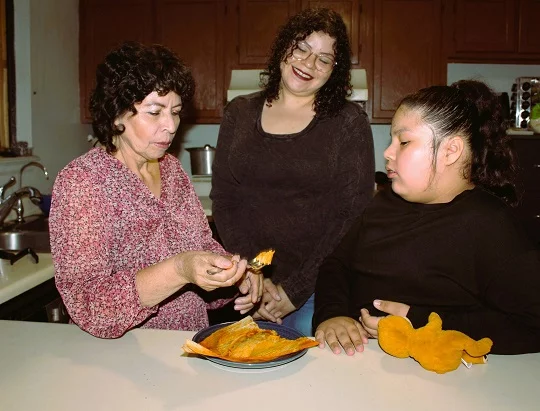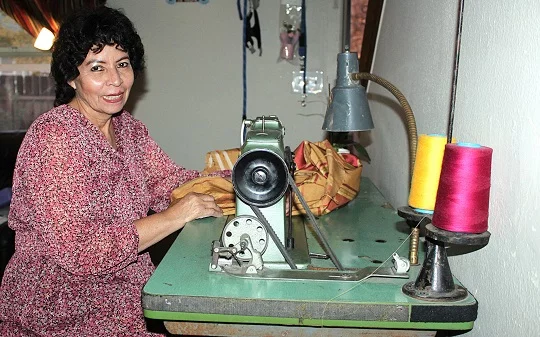
A persistent cough started causing chest pains for Haidee Hernandez, a 62-year-old mother of six.
Every night, after Denver’s Lindsey-Flanigan Courthouse closed and the employees went home, Haidee arrived with her cleaning supplies. As a contract employee for a company that provides cleaning services in government buildings, Haidee earned $18 an hour and worked four hours each evening, thoroughly scrubbing the bathrooms to ensure they would be spotless for the following day.
To supplement her income, Haidee made and sold Mexican tamales filled with chile and cheese. She also took on sewing work, using an antique green sewing machine that she had repaired. Although she no longer uses the sewing machine, she keeps it in the living room of her apartment in Aurora, Colorado.
Haidee believes she developed a persistent cough after contracting COVID-19 without getting any medical care during the pandemic. Despite her desire and need to work, she felt terrible and struggled to carry on with her busy schedule.
Haidee realized she needed to see a doctor, but there was one obstacle: she didn’t have health insurance.
Life taught Haidee to be resourceful from a very young age. She recalls her childhood selling fruit with her mother and sister, starting at age 10 in her native El Salvador.
Seeking care for her cough during a trip to Mexico
Since Haidee had never seen a doctor in the U.S., she decided to seek care during a trip to visit a friend in Mexico.
There, a doctor diagnosed Haidee with a condition called “atypical pneumonia.”
She also received an X-ray and mammogram that led to a difficult and unexpected diagnosis: breast cancer. (Learn how a mammogram saved a woman´s life )
Haidee had what’s known as Invasive Ductal Carcinoma, a common type of breast cancer where cancer cells in the milk ducts spread to surrounding breast tissue.
“I felt sad when I received that diagnosis and thought that what I was going through was very difficult,’’ Haidee said.
Doctors removed the tumor but also recommended chemotherapy and radiation.
When Haidee returned to her home in Colorado, she tried to manage without additional cancer treatments.
But her health continued to decline. At 4 feet, 11 inches tall, Haidee kept losing weight and eventually weighed just 100 pounds after unintentionally losing 50 pounds.
“I couldn’t do anything for myself, absolutely nothing, not even get in the car. I needed my daughter to help me sit down, someone to take me to the bathroom, someone to help me bathe. All of that,” Haidee said.
She also suffered emotionally. Her identity as the strong matriarch of her family and a successful breadwinner was shattered. She was too sick to continue working.
Haidee’s daughter, Elizabeth Hernandez, 32, helped her brainstorm about how to find help. She took her mom to UCHealth University of Colorado Hospital, where ER doctors helped the mother and daughter connect with cancer specialists and financial counselors. Since Haidee was uninsured and had a very low income, the counselors helped her apply for the hospital’s discounted care program. Altogether last year, UCHealth provided nearly $570 million in uncompensated care for patients and $1.3 billion in community benefits. (Learn about where you should go for medical help).
Connecting with a cancer specialist who helped Haidee get the care she needed

Haidee soon was receiving care from Dr. Enrique Soto Pérez de Celis, a medical oncologist who specializes in breast cancer at the UCHealth Diane O’Connor Thompson Breast Center – Anschutz Medical Campus.
Soto diagnosed Haidee with HER2-positive breast cancer. This type of breast cancer is characterized by elevated levels of the HER2 protein, which causes rapid growth of cancer cells due to overproduction of this protein.
Between 15% and 20% of patients with breast cancer have higher levels of the HER2 protein, according to data from experts at the American Cancer Society.
Breast cancer risks and outcomes for Hispanic women
The average age of breast cancer diagnosis among Hispanic women is between 57 and 60 years, according to experts at Epic Research.
Haidee was 60 when she received her diagnosis, and her main risk factor was her age, Soto said.
Among Hispanic women in the U.S., breast cancer is the leading cause of death from cancer, accounting for 16% of all cancer deaths.
Most women with breast cancer — about 90% — do not have a genetic cause for their cancer, meaning they have no family history, according to experts at the U.S. Centers for Disease Control and Prevention.
Like most women, Haidee had no history of breast cancer in her family. Except for getting COVID-19 and suffering from undiagnosed pneumonia, she had been healthy. She didn’t smoke or drink alcohol and was not overweight.
“My life was all about work. All I did was work and come home,” Haidee said.
Soto said it’s typical for women not to have any identifiable causes of breast cancer.
“The risk factors for breast cancer include advanced age, use of hormone replacement therapy, nulliparity (never having had a full-term pregnancy), early onset of menstruation, late menopause and alcohol consumption,” said Soto, who is also a visiting associate professor at the University of Colorado School of Medicine on the Anschutz Medical Campus.
Why early breast cancer detection is critical
In high-income countries like the U.S., survival rates after a breast cancer diagnosis have improved with advances in treatments. Deaths from breast cancer have decreased by up to 40% between 1980 and 2020.
“Early detection and treatment of breast cancer are essential to improving survival, but there are significant gaps in care for Hispanic women,” Soto said.
Among the most significant barriers for Haidee in her journey to overcome breast cancer were a lack of health insurance and language barriers.
Elizabeth, a mother of one girl, has helped Haidee navigate the U.S. health care system since her mother doesn’t speak fluent English.
“The language barrier is a problem. Because of the language barriers, Hispanic women don’t go to doctors and don’t seek help. I had to do my own research. My mom couldn’t do it herself. I did my research about every hospital, trying to find help,” Elizabeth said. (Learn about the DAWN clinic on the Anschutz Medical Campus for uninsured people in Aurora).
Hispanic women like Haidee undergo fewer breast cancer screenings than non-Hispanic white women, primarily due to structural barriers such as less access to health insurance, economic limitations, less availability of health services in their communities and language-related difficulties or mistrust of the system, according to experts at the American Cancer Society.
Poor access to care causes delays in breast cancer diagnoses and treatment for Hispanic women.
“Breast cancer is a disease that arrives unexpectedly,” Haidee said.
After receiving chemotherapy and radiation treatments, Haidee is doing much better and now receives an additional therapy called trastuzumab.
Trastuzumab is the generic name of a drug approved by the U.S. Food and Drug Administration for the treatment of HER2-positive breast cancer, the type of cancer Haidee developed. Haidee and other patients receive the drug through intravenous infusions or subcutaneous injections in the thigh.
Haidee’s cough continues to linger, demanding attention and care.
Soft, free alternative to breast prosthetics
For breast cancer patients who’ve had a mastectomy, local affiliates of the international Knitted Knockers organization offer handmade, soft and comfortable breast prosthetics — free of charge. These lightweight knit options are designed to fit easily into a bra and provide a gentle alternative to traditional prosthetics.
‘‘Haidee’s cough is due to interstitial lung disease,” Soto said. “This appears to be a consequence of pneumonia, not COVID-19, and there is no clear cause in most cases of this illness.”
While the cough has been difficult for Haidee, her decision to seek care ended up helping her get her diagnosis and care for breast cancer.
Haidee continues to receive care for her lung ailments at the UCHealth Pulmonology Clinic-Anschutz.
‘‘The pulmonary medicine team treated her with steroids and other immunosuppressive medications, and she improved, although she still has the disease in her lungs, and we are monitoring her closely,” Soto said. “Haidee’s cough has improved but is still persistent, and she needs oxygen.”
Relief and gratitude for the care she is receiving
Haidee and her family are incredibly grateful that she was able to connect with the experts at University of Colorado Hospital.
“When I started seeing Dr. Soto at UCHealth, I began to feel confident,” Haidee said. “I began to trust the treatments because the doctor encouraged me, and to this day, he still encourages me to continue.”
In her fight against breast cancer, Haidee says she managed the side effects of chemotherapy and radiation very well. Aside from a mild burning sensation in her breast from the radiation, she didn’t experience any major discomfort, which she attributes to carefully following medical recommendations after each procedure and the help of her daughter, who applied cold compresses to soothe the burning.
‘‘We continue to work closely with Haidee to ensure her cancer treatment goes well and that her lungs stay healthy,’’ Soto said.
Positivity and support help her fight breast cancer
For Haidee, it’s important to maintain a positive attitude, despite the challenges of coping with breast cancer.
“You have to keep going, don’t get discouraged,” she said.
Thankfully, she had faith that she would survive.
“I never thought breast cancer would lead to death because it was detected early, before it spread throughout my entire body,” Haidee said.
Her optimistic attitude has enhanced her emotional resilience and overall quality of life as a breast cancer patient.
The most difficult aspect of facing a challenging illness has been her inability to work and help support her family.
“I feel bad that I can’t contribute financially right now. I can’t help my son, who helps me financially,” Haidee said, referring to her youngest son, who is 27 and works for an apartment building in Denver. He is Haidee’s main financial supporter.

Breast self-exams and regular checkups: What every woman should know
Based on her experience, Haidee emphasized the importance of a timely diagnosis and breast self-examination. (Learn about breast imaging and mammograms).
“It’s important to check yourself regularly, to do a breast self-exam. I didn’t check myself very often. When you bathe, touch your breasts and check them,” Haidee said.
Her daughter echoed that advice.
“It’s very important for every woman in every community to practice routine self-breast exams,” Elizabeth said.
Regular mammograms are also essential since some women have breast cancer but don’t feel any lumps in their breasts.
As Haidee fought breast cancer, she relied on the skills and traits she has used all of her life: courage, positivity, and determination.
She also benefited from a team of medical pros who helped her.

‘’From the beginning, our multidisciplinary team — including pharmacy, pulmonology, and rehabilitation — worked together to care for both her cancer and her lungs. Over time, we’ve built a very nice and trusting relationship,’’ Soto said.
Haidee encourages women to seek information about accessing regular medical care and trusting the health system. It’s also vital to follow medical recommendations.
“Doctors know what they’re doing with their patients. They’ll give us the right medicine for each illness. Life goes on, we have to follow treatments, not miss follow-up appointments, and it’s important not to get discouraged,” Haidee said.
Having a regular primary care provider and seeing that person regularly is also important, Soto said.
These health professionals are key to identifying a lump or a change in the breast during routine medical visits that could be breast cancer.
Haidee continues to receive trastuzumab and attends regular follow-up appointments with Soto and her team.
“For patients with breast cancer, it’s important to maintain long-term follow-up, and keep present that treatment can have long-term consequences. We routinely monitor patients in our survivorship clinics, not only to detect recurrences as early as possible, but also to ensure that the survivors’ overall health is excellent,” Soto said.
He loves being able to connect with patients in their native language.
‘‘It has been a privilege to speak with Haidee in Spanish and get to know her and her family. Taking care of Hispanic patients is always special to me, and I believe the bond created by shared language and culture is an important part of high-quality care,” Soto said. (Soto is certified as a bilingual interpreter. Patients who need help communicating with medical providers in their languages may request free assistance from medical interpreters.)
While Haidee no longer sells her tamales, she loves cooking and enjoys making healthy meals. Now that she’s doing better, she has gained back some of the weight she lost.
She’s feeling hopeful now that she has medical experts caring for her.
“Dr. Soto tells me that everything will be okay, that I’m going to be fine,” Haidee said. “I have a lot of faith in my doctor, and everything has gone well with my treatment.”
Early detection of breast cancer saves lives. How to get screened:
- Breast cancer screening tests include mammograms, breast ultrasounds, clinical breast exams, and breast self-exams. (Schedule your mammogram or other breast imaging appointment.)
- Women between the ages of 40 and 74, who are not at high risk for breast cancer, should get a mammogram every two years. Younger women at high risk of breast cancer may need a mammogram earlier. Older women who are at higher risk of getting breast cancer may need more frequent mammograms. Talk to your doctor about the right recommendations for you.
- Breast self-exams can help you identify symptoms of breast cancer, such as lumps, pain or changes in breast size. Learn how to do a breast self-exam. And be sure to inform your primary care provider if you notice any changes in your breasts.
- A breast exam should be part of your regular annual checkup. Your provider will feel your breasts for lumps or changes in the breast tissue that could indicate a serious problem, such as breast cancer.
